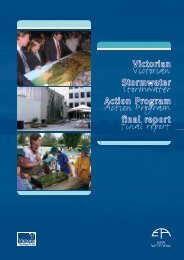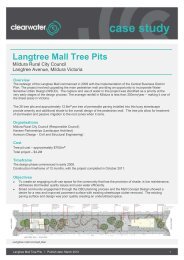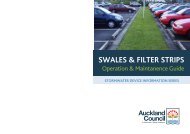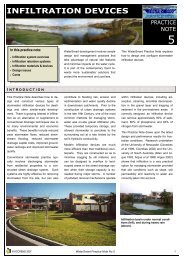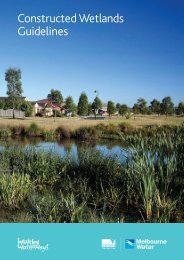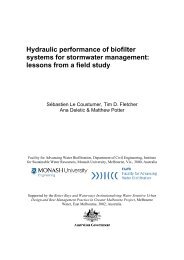CRC Street Sweep Eval 1999.pdf( 489.9 KB ) - Clearwater
CRC Street Sweep Eval 1999.pdf( 489.9 KB ) - Clearwater
CRC Street Sweep Eval 1999.pdf( 489.9 KB ) - Clearwater
You also want an ePaper? Increase the reach of your titles
YUMPU automatically turns print PDFs into web optimized ePapers that Google loves.
COOPERATIVE RESEARCH CENTRE FOR CATCHMENT HYDROLOGY<br />
7 <strong>Street</strong> <strong>Sweep</strong>ing Frequency And<br />
Timing<br />
7.1 <strong>Sweep</strong>ing Frequency and Rainfall Patterns<br />
Sartor and Gaboury (1984) concluded that the<br />
dominant influence on the effectiveness of street<br />
sweeping appears to be time intervals, ie. the<br />
relationship between the average interval between<br />
storm events (a function of local meteorological<br />
conditions) and the frequency at which streets are<br />
swept. <strong>Street</strong> sweeping operations are typically<br />
programmed for a fixed interval (eg. swept once per<br />
week). If the average time between rainfall events is<br />
much less than the sweeping interval, then much of<br />
the street surface load could be washed away by<br />
storm runoff, hence, making street sweeping<br />
relatively ineffective. In this context, analysis of<br />
rainfall statistics is important in the design of street<br />
sweeping programs to ensure street sweeping is<br />
compatible with the frequency of storm events and<br />
therefore optimise the effectiveness of street<br />
sweeping for removal of stormwater pollutants.<br />
Generally street sweeping frequencies are determined<br />
according to land-use. <strong>Street</strong> sweeping frequencies,<br />
practiced by Melbourne metropolitan municipalities,<br />
generally range between daily sweeping for busy<br />
commercial areas and every six weeks for residential<br />
areas. The sweeping frequency in the CBD of<br />
Melbourne could however involve numerous sweeps<br />
throughout the day. Councils ordinarily stipulate<br />
sweeping specifications for the purpose of meeting<br />
community demands for aesthetic quality and amenity<br />
improvement. The inter-event dry period between<br />
storms is not often a factor considered when street<br />
sweeping programs are formulated. However, if<br />
municipalities are willing to incorporate stormwater<br />
management objectives into street sweeping<br />
programs, the occurrence of rainfall events should<br />
become a significant design factor.<br />
The minimisation of pollutant washoff, particularly<br />
fine particulates and associated contaminants, from<br />
street surfaces requires compatibility of street<br />
sweeping frequency and timing with rainfall<br />
characteristics and the daily activities in the<br />
catchment. Fine particulates and associated<br />
contaminants are often mobilised with even the<br />
smallest amount of runoff while gross pollutants often<br />
require a minimum runoff rate to be reached before<br />
they are mobilised. In areas which are not swept<br />
daily, the selected street sweeping frequency should<br />
ideally reflect the relationship with the inter-event dry<br />
period (time between storm events) typical of the<br />
catchment. For those catchments currently on a daily<br />
street sweeping regime, the time of day when street<br />
sweeping is conducted should be selected to limit the<br />
period in which the pollutants deposited on street<br />
surfaces are exposed to the risk or likelihood of washoff<br />
associated with a storm event.<br />
7.2 Inter-Event Dry Period<br />
It can be assumed that the majority of pollutants<br />
transported into the stormwater system occur during<br />
rainfall event periods. Therefore if the street cleaning<br />
frequency is longer than the average inter-event dry<br />
period it can be expected that the accumulated<br />
pollutants, on road surfaces, will have a higher<br />
likelihood of being washed into the stormwater<br />
system before being collected by the street sweeper.<br />
Melbourne rainfall was characterised from analysis of<br />
rainfall over a 105 year period by Wong (1996). The<br />
analysis identified storm events as having a thirty<br />
minute minimum storm duration. A six hour<br />
minimum period of no rainfall to define the<br />
conclusion of a rainfall event. Using this definition<br />
for a storm event, the analysis found the mean period<br />
between storms in Melbourne to be 62.4 hours (2.6<br />
days) with a standard deviation of 76.8 hours (3.2<br />
days). There is an apparent trend in Melbourne of<br />
longer periods between storms in summer months,<br />
with a maximum mean period of 108 hours (4.5 days)<br />
in February and a minimum mean period of 45 hours<br />
(1.9 days) in August as shown in Figure 7.1. Wong<br />
(1996) also carried out an analysis of the rainfall data<br />
for a number of major cities in Australia, and the<br />
statistics according to their respective months are<br />
presented in Table 7.1. The influence of seasonality<br />
on the period between storms for the cities is shown<br />
in Figure 7.2.<br />
21




